New research demonstrates that well-managed planted indigenous forest is better at sequestering carbon and faster growing than commonly considered.
Data from Tāne’s Tree Trust Indigenous Plantation Database show that:
- carbon sequestration for planted forests of totara, kauri, kahikatea, rimu, other conifers, puriri, beech, and other broadleaves is in the range:
- 10.0 to 16.4 tCO2 ha-1 yr-1 (mean annual increment over 50 years) and
- 18.2 to 29.9 tCO2 ha-1 yr-1 (current annual increment at age 50 years)
- growth rates of these native tree species increase steadily over the first 50 years achieving higher productivity as well as carbon sequestration with age.
This research is a first for planted native forest using methodology comparable to that used for planted radiata pine forest in New Zealand (mean annual increment is 21 to 27 tCO2 ha-1 yr-1 for radiata pine at age 50 years).
New Zealand’s Carbon Look-up Tables for the Emission Trading Scheme should include the option for planted native forest as well as regenerating native forest.
The current Carbon Look-up Table for natives is currently accurate only for naturally regenerating kanuka/manuka shrubland (6.5 tCO2 ha-1 yr-1 mean annual increment over 50 years). However, Tāne’s Tree Trust data indicates that, while lower than planted native forest, naturally regenerating native forest can still achieve good levels of sequestration over a long timeframe with the inclusion of climax tree species such as totara.
Landowners can be encouraged by this new research. The difference between pine and well managed planted native forest is much less than is often suggested. Planted native trees will store carbon at a growing pace as they age, as well as enhancing natural landscapes, indigenous biodiversity and cultural values.
Introduction
Concerns about elevated atmospheric CO2 quite rightly focus on its biggest source, that which is the combustion of fossil fuels, and our primary concern must be to reduce our dependence on this carbon which has been stored over many millions of years. However, it is important to realise that globally, about one-third of the elevation in atmospheric CO2 since pre-industrial times has been caused by forest clearance (IPCC, 2014).
New Zealand provides a prime example of this. Prior to human settlement New Zealand was essentially covered in native forest but in a relatively short period (about 800 years) this has been reduced to only 28% of the land surface, and mainly on sites that were inaccessible or where the quality of forest was too poor to attract the timber industry. The release of carbon from that clearance was immense – the book The Story of the Kauri by AH Reed records this tragic tale of destruction.
It is estimated that today we have around 6.6 billion tonnes of CO2 equivalent stored in our remaining native forests although this forest being largely mature is not currently storing much additional carbon. But because new forests have the capacity to sequester large amounts of carbon, there is worldwide interest in helping ameliorate the carbon problem by planting trees and turning that carbon back into storage and useful product.
Shaping the narrative
Two somewhat related matters in New Zealand have influenced our thinking about including native forests in this discussion.
Firstly, the exceptional rates at which the exotic radiata pine (Pinus radiata) grows in this country. A combination of a rather extraordinary tree backed up by sixty years of research, improved technology, and a very experienced and capable team of practitioners, has resulted in a tree and a forest with outstanding production and therefore carbon assimilation properties.
Secondly, as already noted, native forest was removed from most, if not all, the fertile soils of the lowlands and our current impression of native forest growth is consigned to our most difficult country and reverting secondary forest.
Tāne’s Tree Trust Indigenous Plantation Database
Remarkably limited measures of carbon sequestration by native forests have been made in New Zealand. However, Tāne’s Tree Trust (TTT) has produced its Carbon Calculator for Planted Native Forest based on the Trust’s Indigenous Plantation Database (Bergin and Kimberley 2012). This database of measurements of planted native forest and shrubland is based around a comprehensive survey completed in 2010 from throughout New Zealand but also includes earlier measurements collected over several decades.
Although many of the planted native stands represented in the database are small and have not been well managed, this database constitutes the largest and best available information on growth rates of plantations of native trees that we have in New Zealand with over 10,000 measured native trees and shrubs. Stand densities are relatively high with surveys targeting mostly single-species tree plantations with an average density of 1450 stems per ha. Shrubs were mixed-species plantings with an average density of 4075 stems per ha.
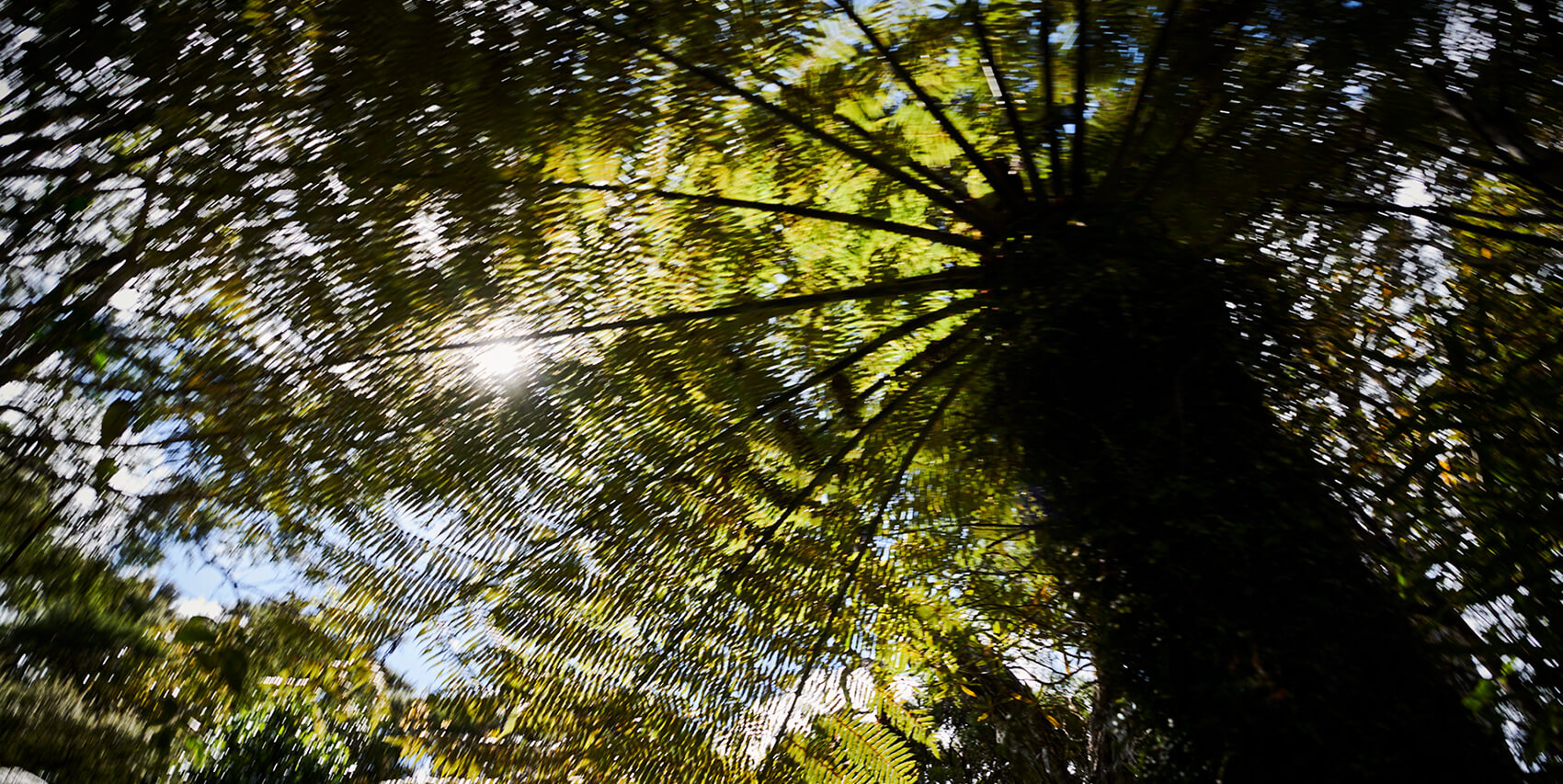
Photo credit Alistair Guthrie @alistairguthrie
Carbon MAIs vs CAIs – know the difference
Measures of carbon sequestration in trees and forests are derived from the annual increase in stem, branch, foliage, and root mass, which includes a high proportion of molecular carbon. While different species of tree, and even the same species growing in different locations, may have somewhat different wood densities (and therefore different quantities of stored carbon), it is relatively easy to relate volume production in forests to tonnes of CO2 stored per hectare. Methods for doing this are provided by Beets et al. (2012, 2014). Dividing this total by its age provides the growth and thus sequestration rate as a Mean Annual Increment (MAI) in units of tCO2 ha-1 yr-1.
Because growth varies through the life of a tree, growth at a particular point in time is referred to as the Current Annual Increment (CAI) and is derived from measurements made over shorter intervals of time. As will be shown, this can increase markedly as trees become established.
In any situation or on any site there is a range of production that can be achieved by forests. At the low end (such as in very young forest or forests of slow growing species), annual rates of only 1-4 tonnes of growth per ha may be typical. With fast-growing species values significantly greater than 30 tonnes can be achieved. A range of 4-30 tonnes of CO2 sequestration per ha per annum is probably typical of MAIs for New Zealand situations although rates outside this range do occur.
Carbon Look-up Tables for exotic and native forest
The Look-up Tables published by The Ministry for Primary Industries are used by small forest growers to estimate carbon stock for the Emissions Trading Scheme(ETS). The Look-up Table for radiata pine lists its carbon MAI over 50 years as between 21 and 27 tCO2 ha-1 yr-1 depending on region, which is recognised as at the higher end compared with what forests in other parts of the world can achieve.
Only one Look-up Table is provided for indigenous forest, and this lists the carbon MAI over 50 years as 6.5 tCO2 ha-1 yr-1. It is this value that many associate with native forest sequestration including planted native forest. However, this table was derived from measurements of naturally regenerating shrubland. A recent study of native forest carbon sequestration rates undertaken by Kimberley and Bergin (2021 in preparation) covers various forest types ranging from naturally regenerating native scrub through to planted and managed native forest stands. This latter work represents the only measured native forest that is in any way comparable to the many thousands of biomass and carbon measurements made for radiata pine in New Zealand.
Importantly, this study clearly demonstrates that planted and managed native trees and forests exceed the Look-up Table rate of 6.5 tCO2 ha-1 yr-1 by significant margins and it is clear that the Look-up Tables need to be adjusted to reflect this situation. The following sections summarise the results of this study firstly for naturally regenerating shrubland and forest, and then for planted native forest.
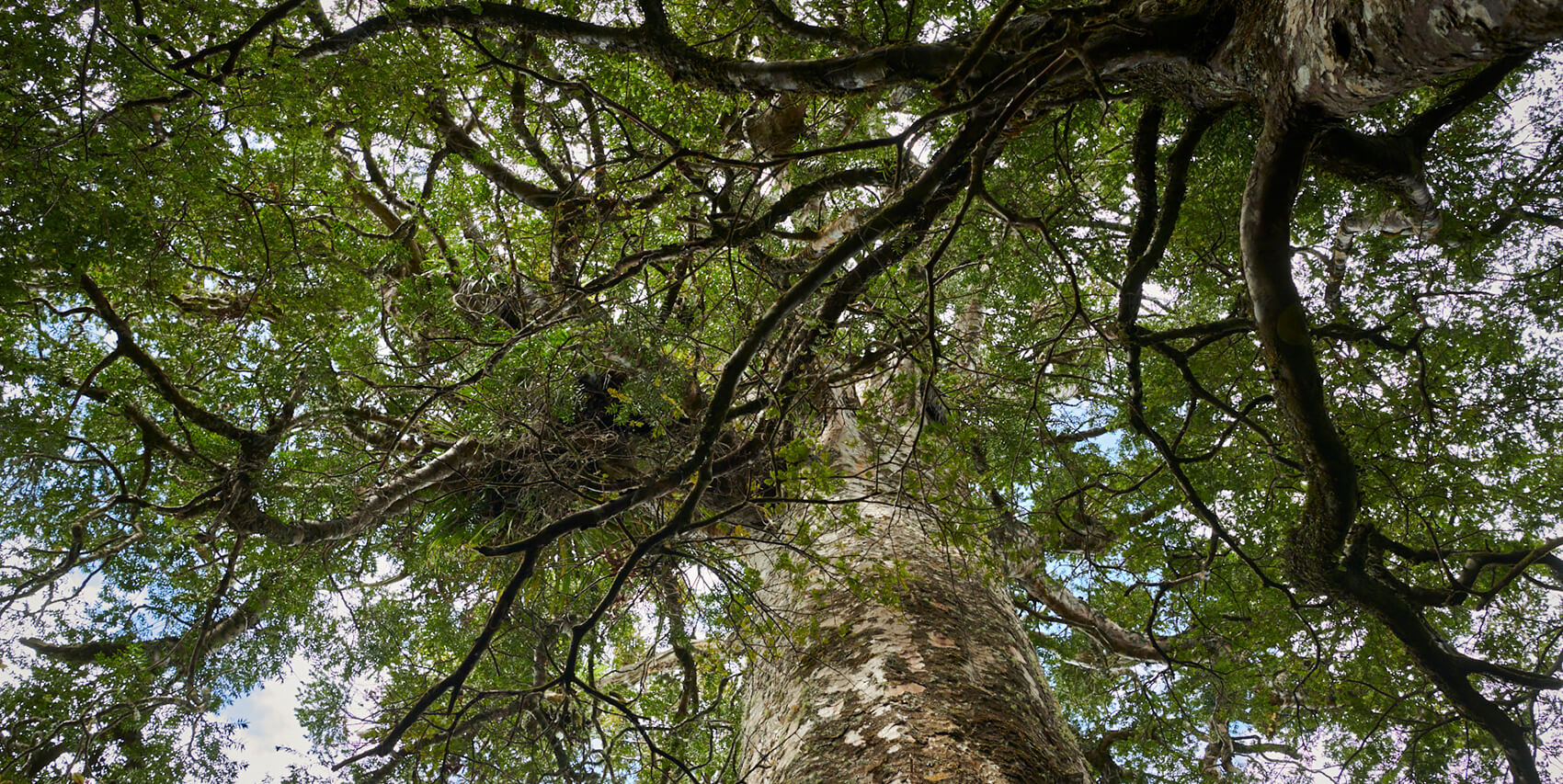
Photo credit Alistair Guthrie @alistairguthrie
Naturally regenerating native shrubland and forest
Carbon sequestration rates by regenerating native shrublands are available from an inventory of New Zealand natural post-1989 forest carried out by the Ministry for the Environment in 2012 (Beets et al. 2014). The carbon MAI of measurement plots in this inventory ranged from 1.6 to 17.7 tCO2 ha-1 yr-1 and averaged 7.0 tCO2 ha-1 yr-1, close to the Look-up Table value. This inventory covered natural shrubland that has established since 1989 and therefore consisted of stands mostly less than 25 years old.
Carbon sequestration rates in regenerating native shrubland covering a wider age range are provided from data collected by Bergin et al. (1995) in naturally regenerating manuka/kanuka shrubland in the East Coast of the North Island. Manuka dominates these shrublands until about age 15 years and then declines with kanuka becoming dominant. Carbon sequestration averaged about 10 tCO2 ha-1 yr-1 over the first 20 years but then slowed considerably with little additional sequestration occurring beyond age 30 years (Figure 1).
While sequestration in manuka/kanuka shrubland declines rapidly after 30 or so years, regenerating climax species such as totara can often naturally enter the mix, eventually outcompeting the shrub species. Such species can continue to sequester carbon over many decades. Data from a study of naturally regenerating fully-stocked totara-dominant stands sampled in Northland (Bergin 2001), show carbon sequestration rates averaging 10 tCO2 ha-1 yr-1 continue to be maintained over the 120-year age range covered by the study (Figure 1).
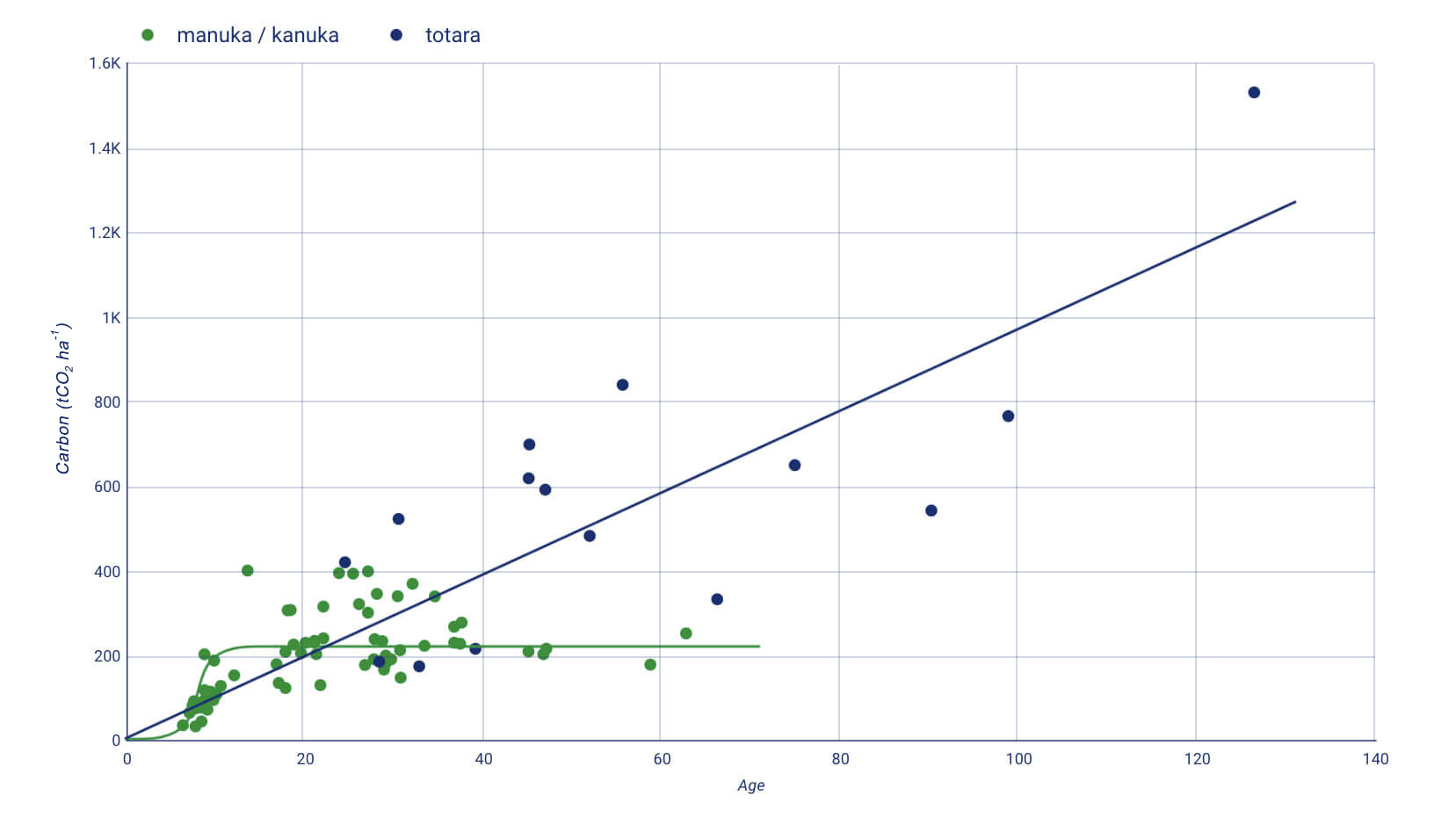
Figure 1. Carbon sequestration in regenerating manuka/kanuka shrubland on the East Coast of the North Island and in regenerating totara-dominated forest in Northland.
Planted and managed native stands
As most of the focus is on carbon assimilation by radiata pine in New Zealand, and with the data invariably from planted and managed stands, it is essential to compare like with like in an objective analysis. Data from the Tāne’s Tree Trust Indigenous Plantation Database provides the most robust information available for planted native forest.
Growth and yield information in planted stands containing the two most commonly planted native tree species, totara and kauri, show a trend of gradual increase as stands age. Growth is generally slower initially but increases at least up until the maximum ages of stands in the study, 70 years for kauri and 100 years for totara (Figure 2).
On average, kauri stores carbon more rapidly than totara with an average MAI of 16.4 tCO2 ha-1 yr-1 at age 50 years. Totara has a somewhat slower increase in carbon sequestration than kauri at a comparable age, with the MAI averaging only 10.0 tCO2 ha-1 yr-1 at age 50 years, although this increases to 15.1 tCO2 ha-1 yr-1 by age 100 years. The lower carbon sequestration rate of totara is in part due to its lower wood density compared to many other native conifers.
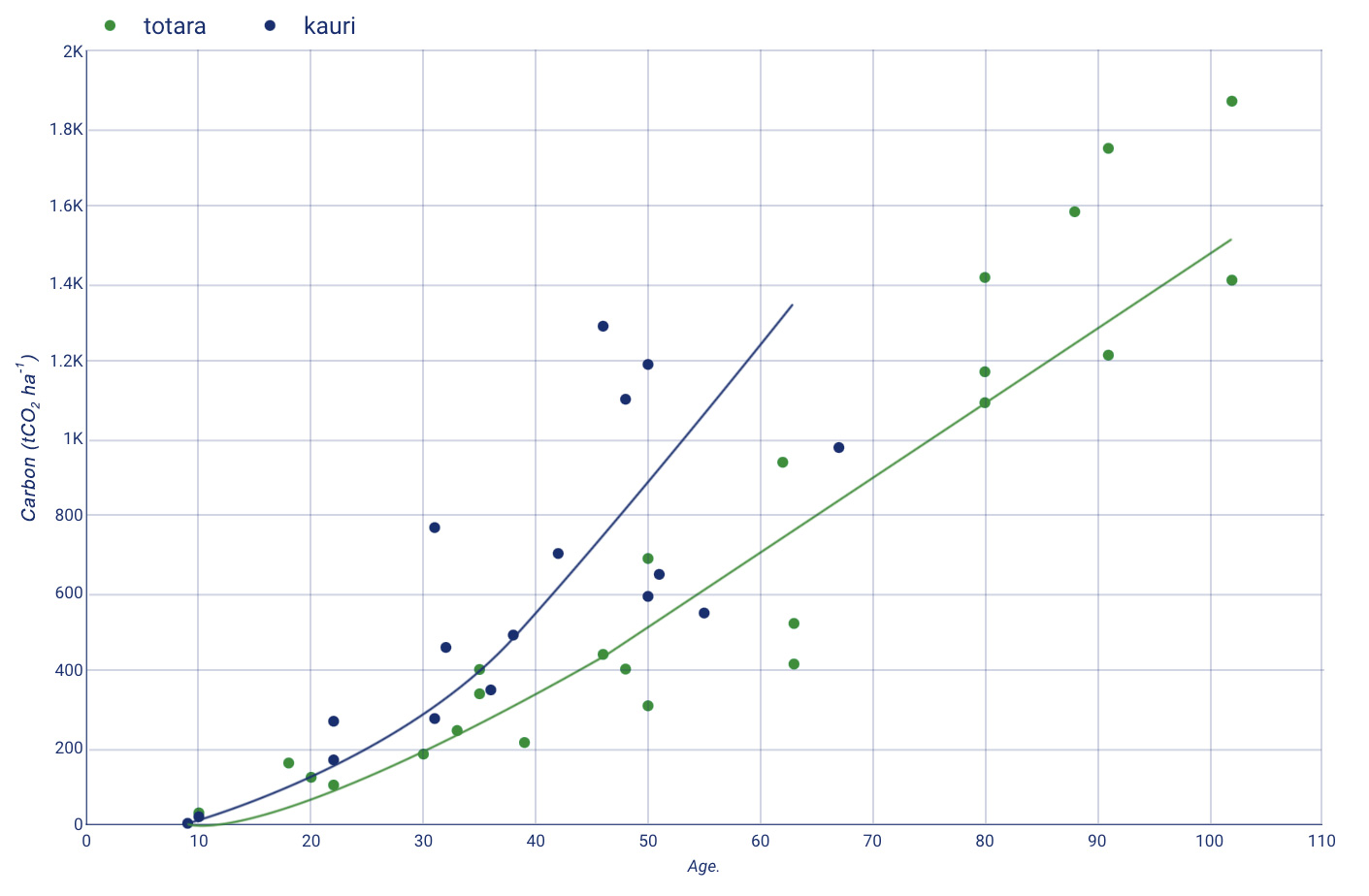
Figure 2. Carbon sequestration in planted kauri and totara forests.
Of course, this data is still limited as planting is often still in a “trial” capacity, landowners have planted species of interest to themselves with less regard for provenance, the appropriateness of the site or the sort of silviculture that should be applied subsequently. Nevertheless, some work has been done which demonstrates that with attention to forest husbandry some even more impressive results can be obtained.
Mean Annual Increments for planted natives
Further analysis of the TTT database provides the table below which gives a summary of MAIs for a range of New Zealand species. Sequestration rates for planted kahikatea, rimu, puriri and beech are comparable to those of totara and kauri, with MAIs averaging between 10 and 15 tCO2 ha-1 yr-1 at age 50 years (Table 1). For comparison, the Look-up Tables for radiata pine give average sequestration rates of 21 to 27 t CO2 ha-1 yr-1 at age 50 years.
Sequestration rates of planted native tree species are low during the first few decades after planting with MAIs averaging only 3-6 tCO2 ha-1 yr-1 at age 20 years. However, plantings of mixed native shrub species have much higher rates averaging 17.8 tCO2 ha-1 yr-1 at age 20 years, partly because of the high stockings they are generally planted at, but also because many of these species have fast early growth. It is common practice to establish mixed plantings of native tree and shrub species with the shrub component boosting the early carbon sequestration until the tree species become dominant after several decades.
Table 1. Average carbon sequestration mean annual increment (MAI) of commonly
planted native tree species and mixed shrub species.
| Age (years) | CO2 sequestration mean annual increment (tCO2 ha-1 yr-1) | ||||||||
| totara | kauri | kahikatea | rimu | other conifers | puriri | beech | other broadleaves | mixed shrubs | |
| 10 | 1.6 | 1.9 | 1.3 | 1.8 | 1.7 | 1.0 | 1.8 | 1.5 | 14.7 |
| 20 | 3.9 | 5.6 | 4.0 | 5.2 | 5.1 | 3.2 | 5.2 | 4.6 | 17.8 |
| 30 | 6.1 | 9.7 | 7.1 | 9.0 | 8.9 | 5.8 | 9.0 | 8.0 | |
| 40 | 8.2 | 13.3 | 10.1 | 12.4 | 12.3 | 8.3 | 12.5 | 11.3 | |
| 50 | 10.0 | 16.4 | 12.7 | 15.4 | 15.2 | 10.6 | 15.4 | 14.0 | |
| 60 | 11.5 | 18.7 | 14.8 | 17.6 | 12.6 | 17.8 | 16.3 | ||
| 70 | 12.7 | 20.5 | 16.6 | 19.3 | 14.2 | 19.5 | 18.0 | ||
| 80 | 13.7 | 20.7 | |||||||
| 90 | 14.5 | 21.5 | |||||||
| 100 | 15.1 | 21.9 | |||||||
| 110 | 15.5 | 22.0 | |||||||
| 120 | 15.8 | ||||||||
Current Annual Increments for planted natives
The carbon sequestration curves for planted tree species (Figure 2) show a trend of productivity increasing steadily with age. This increase in growth rates from age 30 years can be seen in Table 2 which shows CAIs by species and age. At 50 years, while totara is under 20, all other conifer and hardwood tree species have CAIs between 20 and 30 t CO2 ha-1 yr-1.
Table 2. Average carbon sequestration current annual increment (CAI) of commonly
planted native tree species and mixed shrub species.
|
Age (years) |
CO2 sequestration current annual increment (tCO2 ha-1 yr-1) |
||||||||
|
totara |
kauri | kahikatea | rimu | other conifers | puriri | beech | other broadleaves |
mixed shrubs |
|
| 10 | 3.8 | 5.1 | 3.6 | 4.7 | 4.6 | 2.8 | 4.7 | 4.1 | 32.7 |
| 20 | 8.5 | 13.7 | 10.1 | 12.7 | 12.6 | 8.1 | 12.8 | 11.4 | 8.8 |
| 30 | 12.6 | 21.4 | 16.3 | 20.0 | 19.8 | 13.5 | 20.1 | 18.2 | |
| 40 | 15.9 | 26.8 | 21.3 | 25.4 | 25.2 | 18.1 | 25.4 | 23.4 | |
| 50 | 18.2 | 29.9 | 24.6 | 28.6 | 28.4 | 21.4 | 28.6 | 26.7 | |
| 60 | 19.8 | 30.9 | 26.5 | 29.7 | 23.5 | 29.9 | 28.2 | ||
| 70 | 20.6 | 30.5 | 27.0 | 29.6 | 24.5 | 29.7 | 28.5 | ||
| 80 | 20.8 | 28.6 | |||||||
| 90 | 20.7 | 26.7 | |||||||
| 100 | 20.1 | 24.5 | |||||||
| 110 | 19.4 | 22.2 | |||||||
| 120 | 18.4 | ||||||||
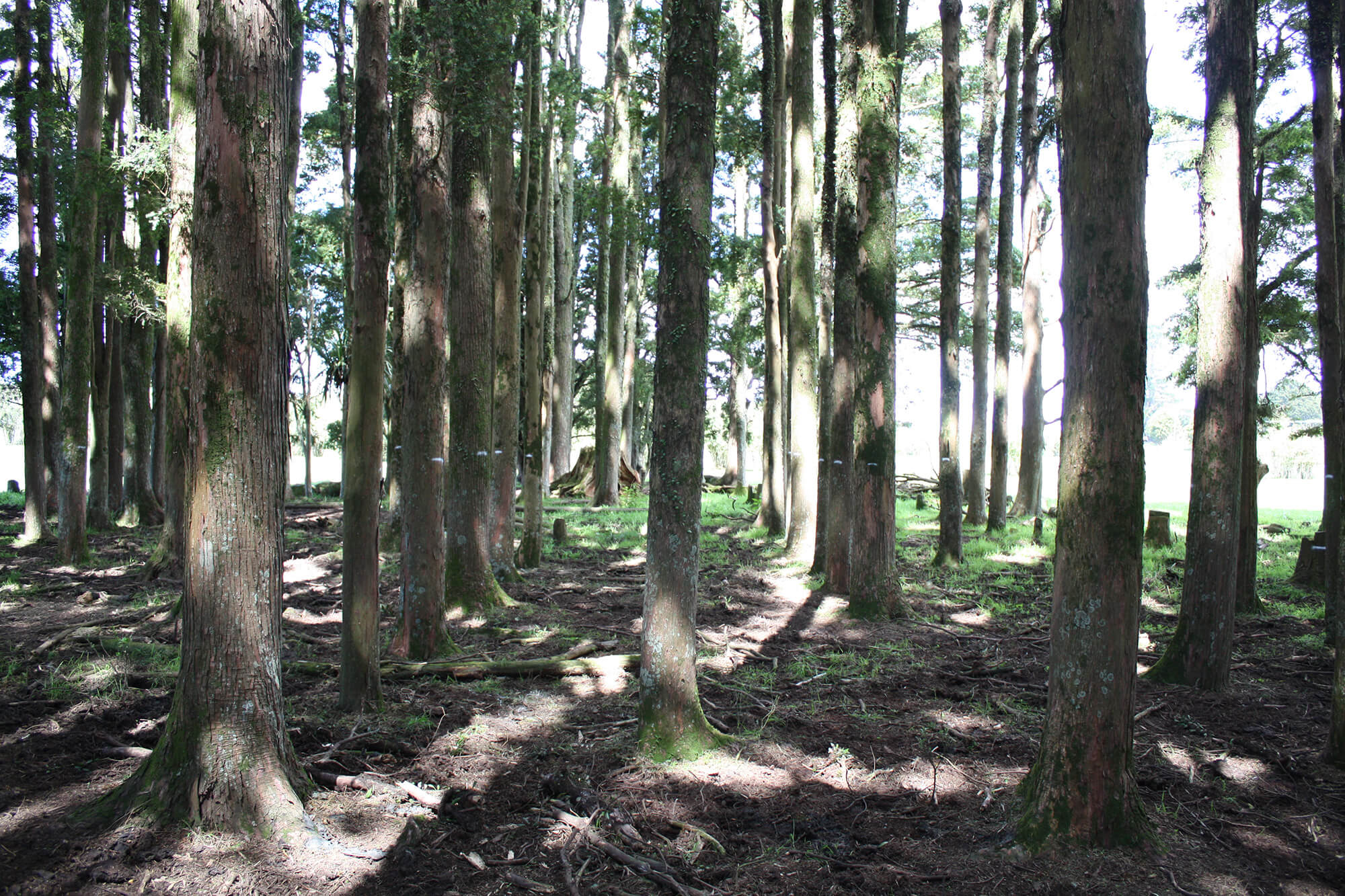
Photo credit Michael Bergin @mikeb_nz
A 102-year-old stand of planted totara in Northland with a stocking of 1640 stems per ha is estimated to have sequestered 1639 tCO2 ha-1 since planting, representing an MAI of 16.4 tCO2 ha-1 yr-1.
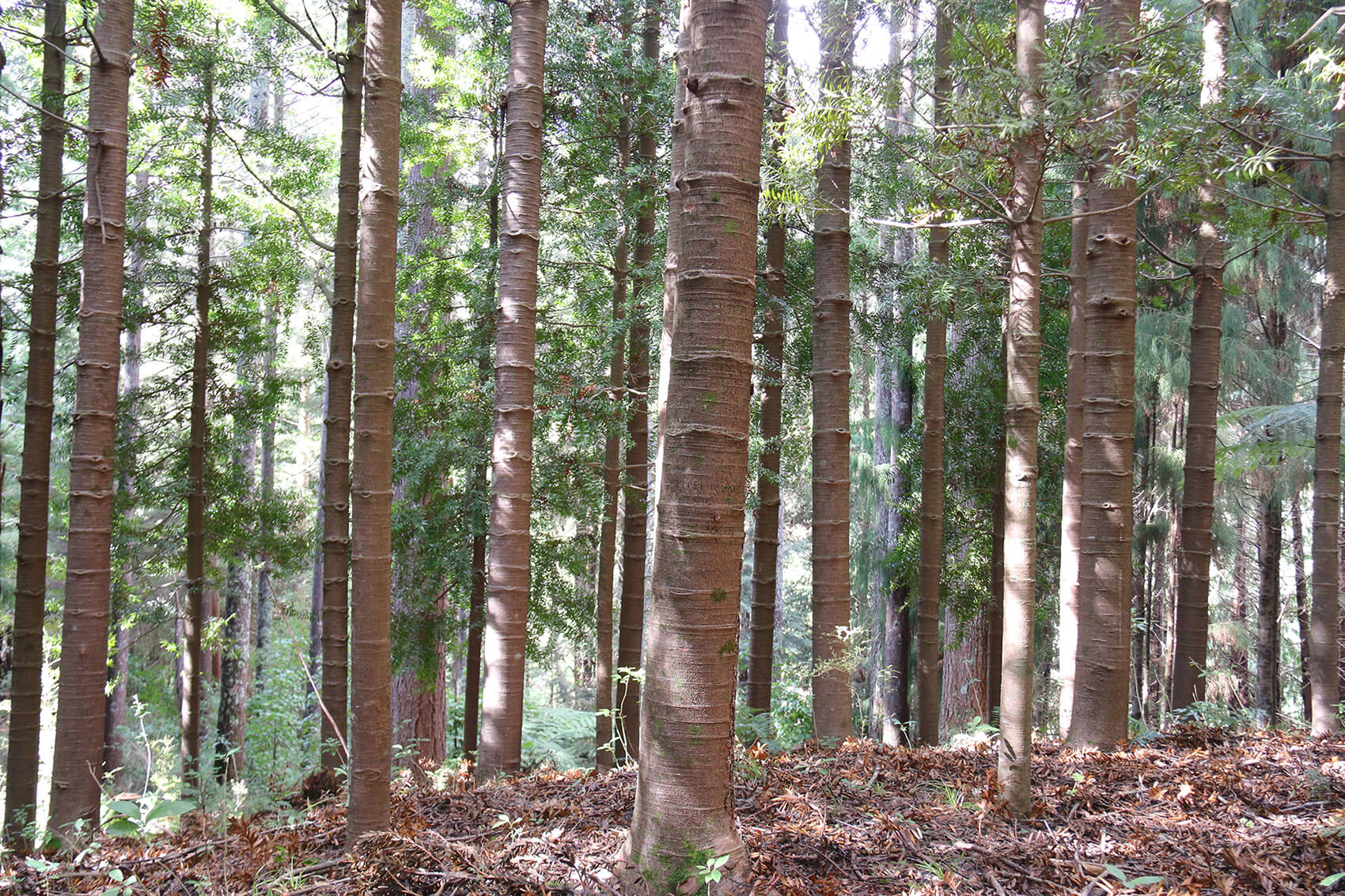
A grove of kauri planted in 1963 in the Holts Forest Trust Sanctuary, Hawkes Bay. At 48 years old and a high stocking of 2000 stems per ha it is estimated to have sequestered 1100 tCO2 ha-1 since planting representing an MAI of 22.9 tCO2 ha-1 yr-1.
Conclusion
The widely held view that New Zealand native forests are slower growing and accordingly slower to sequester carbon, as indicated by the MPI Look-up Tables, may be discouraging landowners from planting native trees, even where it is their preference to do so. Worse, it may be leading to planting advice that is incorrect and not helpful at a time when any form of tree planting by landowners is a bonus.
Analysis of Tāne’s Tree Trust data from planted native trees still supports the position that radiata pine is initially faster growing and simpler to manage, but the difference between carbon sequestration in radiata pine and well managed planted native forest is much less than is often suggested. And investment in research and development would benefit native forestry as it has the radiata-pine industry, i.e., result in increased growth rates and more knowledge around forest management.
New Zealand’s Carbon Look-up Tables for the Emission Trading Scheme should include the option for planted native forest as well as regenerating native forest. The current Look-up Tables for native forest are accurate when applied to naturally regenerating shrubland. However, to achieve good levels of sequestration over a long timeframe, regenerating forest needs to include climax tree species such as totara.
Properly sited and managed planted native tree species are a good alternative where landowners wish to sequester carbon over long time periods, as well as enhancing natural landscapes, indigenous biodiversity and cultural values.
References
Beets, P.N., Kimberley, M.O., Oliver, G.R., Pearce, S.H., Graham, J.D., Brandon, A. 2012. Allometric equations for estimating carbon stocks in natural forest in New Zealand. Forests, 3: 818-839.
Beets, P.N., Kimberley, M.O., Paul, T.S.H., Oliver, G.R., Pearce, S.H., Buswell, J.M., 2014. The inventory of carbon stocks in New Zealand’s post-1989 natural forest for reporting under the Kyoto Protocol. Forests, 5, 2230-2252.
Bergin, D.O. 2001: Growth and management of planted and regenerating stands of Podocarpus totara D. Don. PhD thesis, University of Waikato. Unpublished. 316p.
Bergin, D., Kimberley, M. 2012. Nationwide survey of planted native trees Tāne’s Tree Trust. Technical Handbook. Technical Article 10.1.
Bergin, D.O.; Kimberley, M.O.; Marden, M. 1993: How soon does regenerating scrub control erosion? New Zealand Forestry, 38(2): 38-40.
Bergin, D.O.; Kimberley, M.O.; Marden, M. 1995: Protective value of regenerating tea tree stands on erosion-prone hill country, East Coast, North Island, New Zealand. New Zealand Journal of Forestry Science, 25 (1): 3-19.
Intergovernmental Panel on Climate Change. (2014). Technical Summary. In Climate Change 2013 – The Physical Science Basis: Working Group I Contribution to the Fifth Assessment Report of the Intergovernmental Panel on Climate Change (pp. 31-116). Cambridge: Cambridge University Press. doi:10.1017/CBO9781107415324.005
Kimberley, M.O..; Bergin, D.O. 2021: Rates of carbon sequestration in planted and regenerating New Zealand native forests. Manuscript in preparation.
Reed, A.H. (1953). The Story of the Kauri. A.H. Reed & A.W. Reed, Wellington, NZ. 439 p.

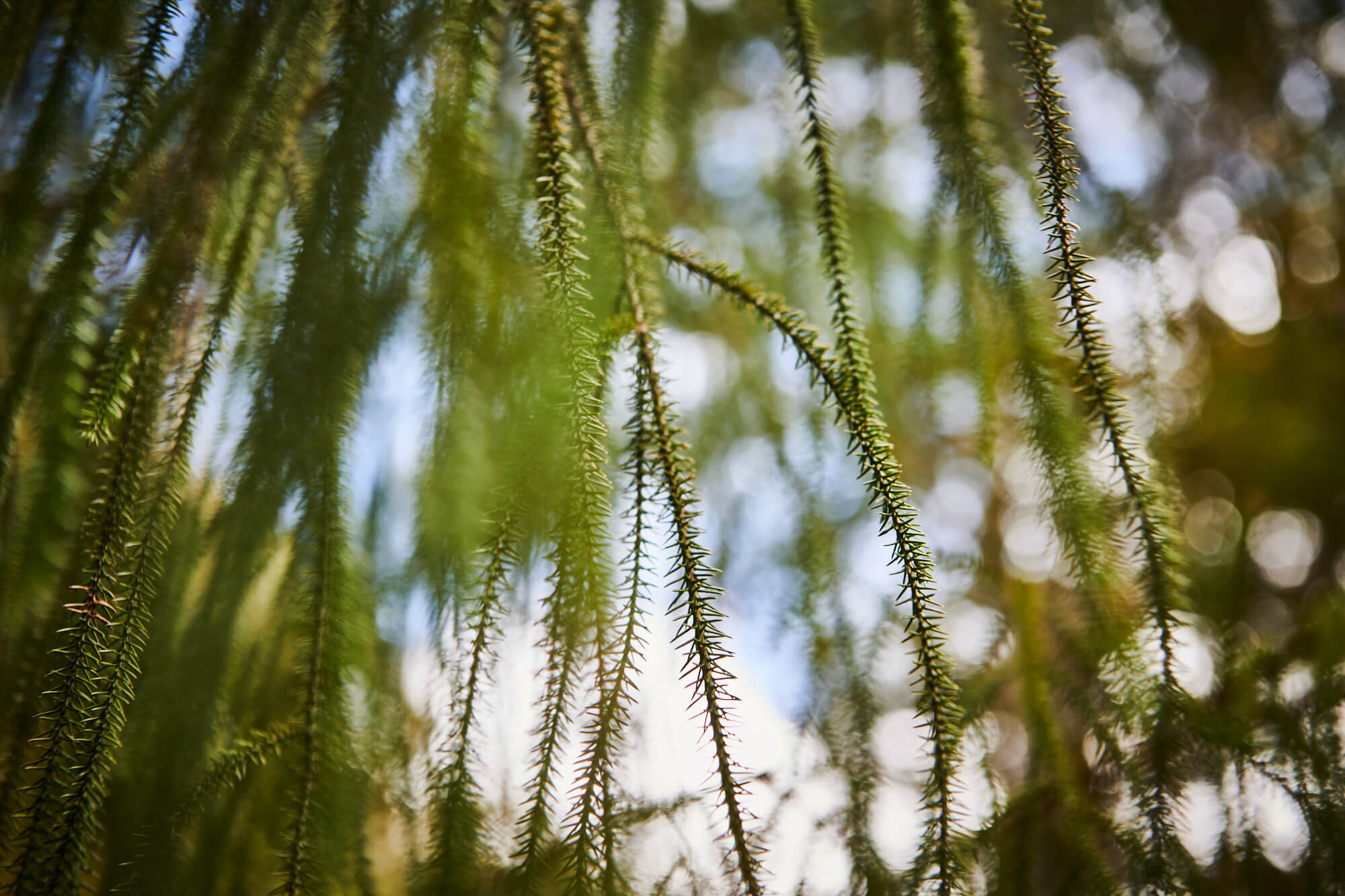

Leave a comment